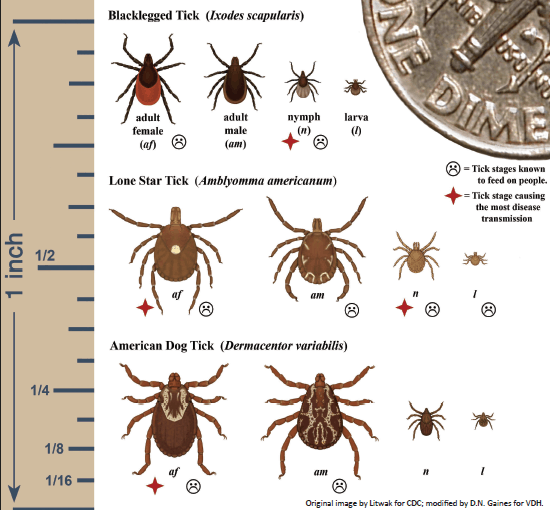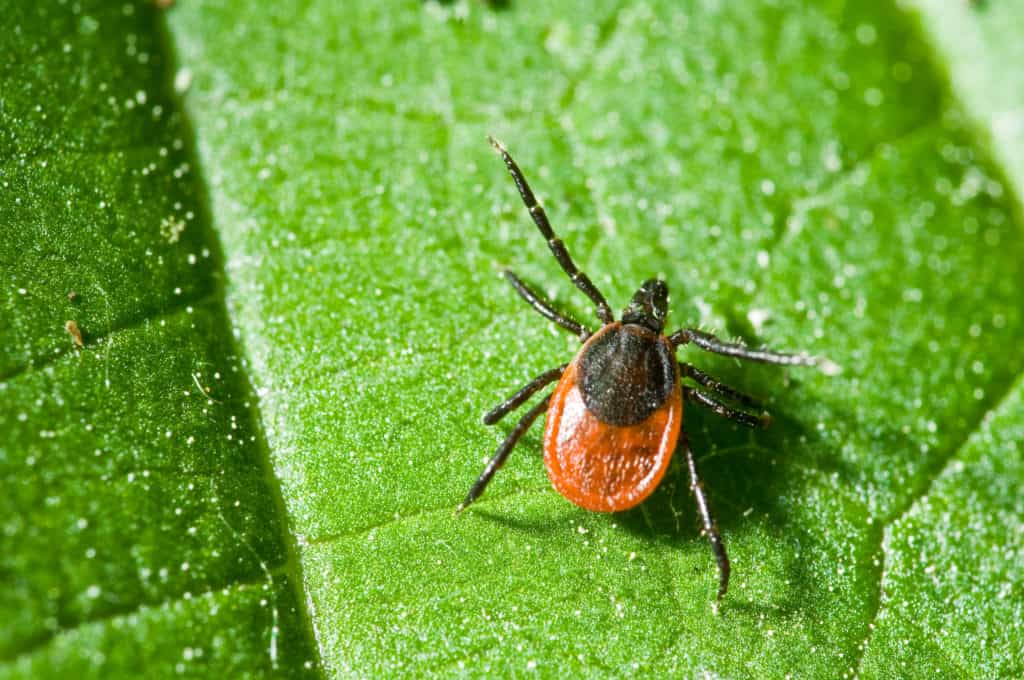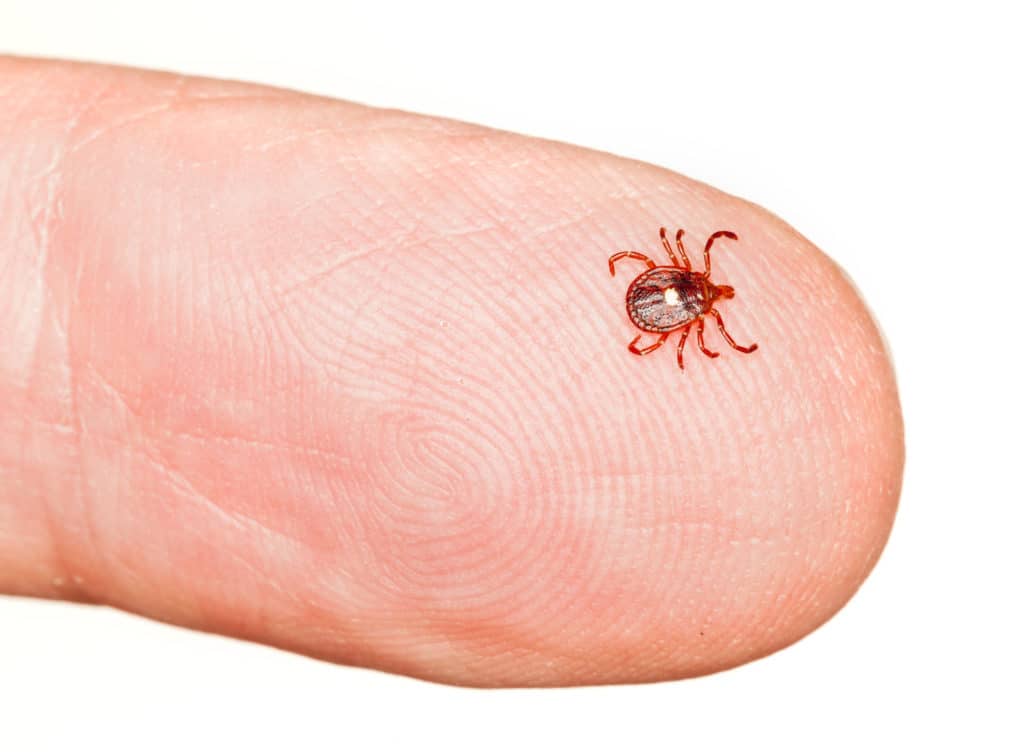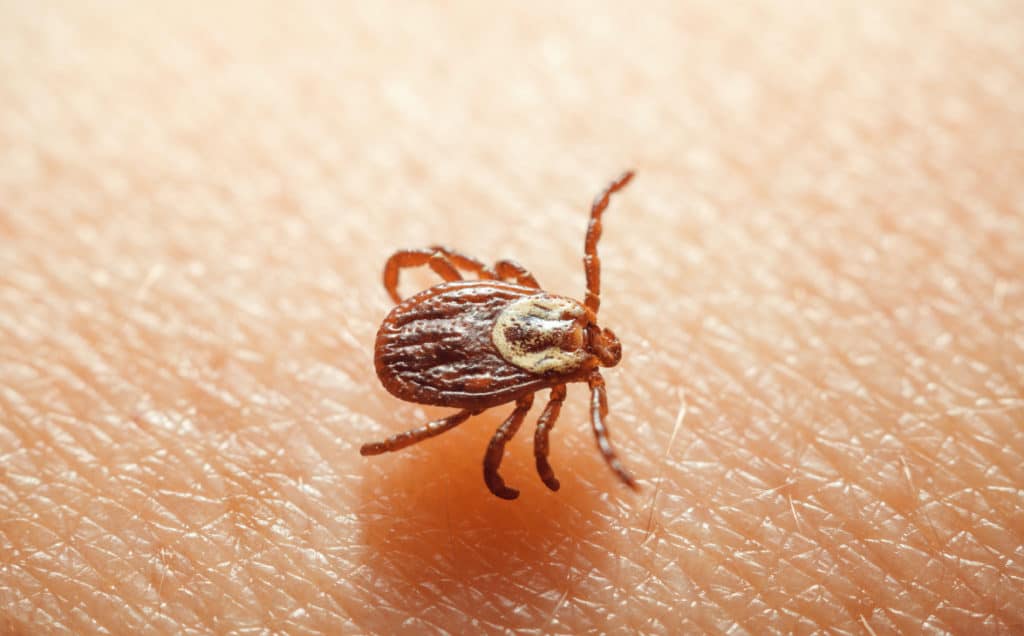3 Most Common Ticks in Virginia
3 Most Common Ticks in Virginia

The Black-Legged Tick / Deer Tick (Ixodes scapularis)
Appearance: The easiest way to distinguish a deer tick is through its dark black legs and the bright red-orange bodies of the females while the males are a brown/black.
Habitat: These ticks prefer areas of higher elevation and rather thickly bushy areas where they would come across deer and other wildlife. They search for victims from short/low vegetation, not trees and rarely travel over 3-4 feet off of the ground.
Life Cycle: After indulging in a blood meal, adult females can produce roughly 1000-3000 eggs at a time. But, as tick death rates are rather high due to predators and other external factors, a good portion of the eggs do not mature to adulthood. Eggs tend to hatch around June/July and by May, the larvae will molt into nymphs and begin feeding until they one again molt, this time into adults. These ticks not only survive through the winter months, but they remain active as long as temperatures do not drop below freezing.
Risk of Disease: The Deer Tick/Black-Legged Tick is infamous for transmitting Lyme disease as well as Human Babesiosis and Human Granulocytic.

The Lone Star Tick (Amblyomma americanum)
Appearance: Lone Star ticks are reddish-brown with hints of yellow. The females are generally larger than their male counterparts and have a distinctive white spot on their backs.
Habitat: These ticks like to hide either in the underbrush or along the edges of clearings or bodies of water.
Life Cycle: Lone Star female ticks deposit roughly 5,000 eggs after feeding on a host. The eggs undergo an incubation period before the larvae emerge seeking a host. The size of the ticks can vary throughout each stage depending on the environmental conditions and genetics. In general, the life cycle of Lone Star ticks lasts up to 2 years.
Risk of Disease: Unfortunately, the Lone Star tick has a very high rate of biting reports and even holds the record for most bites in the southcentral and southeastern United States. They are also known for carrying several different pathogens including Tularemia, Ehrlichiosis, Rickettsiosis, and even can cause Alpha-Gal Syndrome.

The American Dog Tick (Dermacentor variabilis)
Appearance: These ticks have dark brown bodies with an off-white color on their dorsal shield. The female’s off-white coloration is shaped somewhat like a half moon facing their heads, while the males have more of a mottled pattern on their backs. Normally, the ticks are roughly 5mm in length, but can extend to 15mm when engorged with a blood meal.
Habitat: Unlike the Lone Star tick or Deer tick, The American Dog tick avoids areas with heavy tree cover, instead opting to inhabit grassy fields, open meadows and areas with low vegetation that have a high traffic of animals.
Life Cycle: These ticks are extremely resilient and while their average life span is 2-3 years, adults can survive up to 2 years without even feeding. Mating occurs while the female is on the host, and after dropping off and laying her eggs, the female will pass away leaving her roughly 4,000-6,500 eggs to hatch in about a month’s time.
Risk of Disease: The American Dog Tick is the primary carrier of Rocky Mountain Spotted Fever – a terribly infectious disease. These ticks can also pass tularemia and even cause canine tick paralysis in our furry friends.

Citations
Chan, W. and Kaufman, P. (2013) American Dog Tick: Dermacentor variabilis, Entomology and Nematology of the University of Florida. The Florida Department of Agriculture and Consumer Services. Available at: https://entnemdept.ufl.edu/creatures/urban/medical/american_dog_tick.htm (Accessed: July 2020).
Holderman, C. and Kaufman, P. (2020) Lone Star Tick: Amblyomma americanum, Entomology and Nematology of the University of Florida. The Florida Department of Agriculture and Consumer Services. Available at: https://entnemdept.ufl.edu/creatures/urban/medical/lone_star_tick.htm
Mather, T. and Patnaude, M. (2017) Blacklegged Tick or Deer Tick: Ixodes scapularis, Entomology and Nematology of the University of Florida. The Florida Department of Agriculture and Consumer Services. Available at: https://entnemdept.ufl.edu/creatures/urban/medical/deer_tick.htm
Your Field Guide to Battle Ticks (2020) Fairfax County Virginia. Available at: https://www.fairfaxcounty.gov/news2/your-field-guide-to-battle-ticks/ (Accessed: July 2020).
How to Maintain a Pest-Free Kitchen for the Holidays
How to Maintain a Pest-Free Kitchen for the Holidays How to Maintain a Pest-Free Kitchen for the Holidays Summary: This blog educates homeowners [...]
Pests That Invade Packages & Boxes: How to Prevent Hidden Infestations
Pests That Invade Packages & Boxes: How to Prevent Hidden Infestations Pests That Invade Packages & Boxes: How to Prevent Hidden Infestations Summary: [...]
Keep Pests Out of Your Holiday Gatherings
Keep Pests Out of Your Holiday Gatherings Keep Pests Out of Your Holiday Gatherings Summary: The holiday season is all about good food [...]
Cold Weather vs. Warm Weather Infestations: How Temperature Shapes Pest Activity
Cold Weather vs. Warm Weather Infestations: How Temperature Shapes Pest Activity Cold Weather vs. Warm Weather Infestations: How Temperature Shapes Pest Activity Summary: [...]
Garden Pests Do Not Hibernate Indoors – How They Attack Houseplants And What To Do
Garden Pests Do Not Hibernate Indoors – How They Attack Houseplants And What To Do Garden Pests Do Not Hibernate Indoors – How They Attack [...]
The Scariest Pests (And Why They Freak Us Out)
The Scariest Pests (And Why They Freak Us Out) The Scariest Pests (And Why They Freak Us Out) Summary: A practical, homeowner-friendly guide [...]

